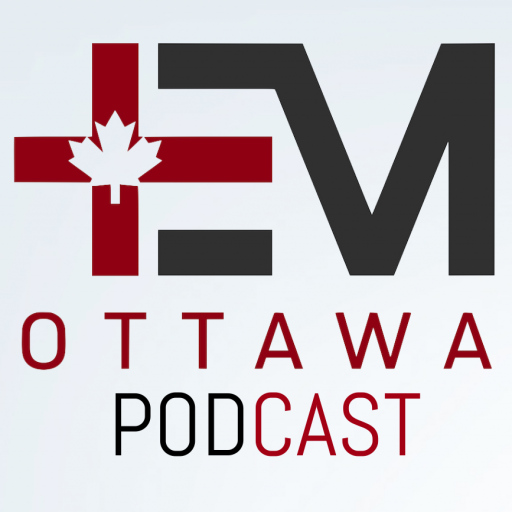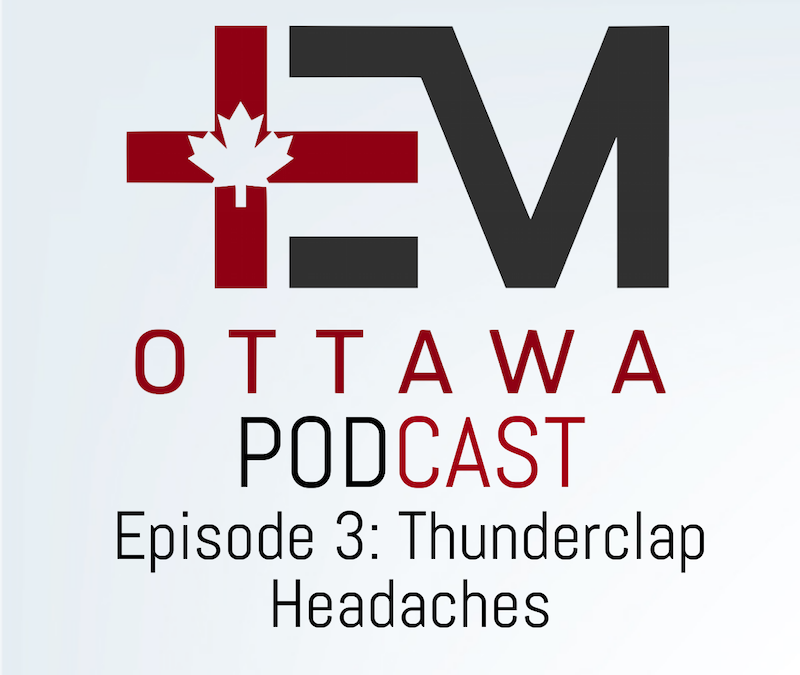On episode three of the Ottawa EM Podcast, Dr. Rajiv Thavanathan (R5) interviews Dr. Michael Hale (R5), on the ED presentation and diagnosis of subarachnoid hemorrhage in the context of the thunderclap headache. (Click here to access Podcast Main menu)
Subarachnoid Hemorrhage (SAH)
Why does the diagnosis matter?
- 30-day mortality of almost 50%.
- Of those who survive a SAH diagnosis, 30-50% are left with significant disabilities.
- While the most common cause of SAH is trauma, this post will specifically focus on non-traumatic SAH, most often due to an aneurysm.
- Note while headache account for 2% of all ED visits, SAH accounts for only 1% of this percentile.
- Most ER doctors will see less than 50 SAH total during an entire career.
Predictive Signs & Symptoms
- Thunderclap headache
- Worst headache of life
- Neck stiffness
- Vomiting
- Loss of consciousness (LoC)
Note: each of these features alone are more likely to be caused by another diagnosis.
In fact, thunderclap headache, although common in SAH, isn’t overlying predictive of SAH. That is to say, most patients presenting with a describe thunderclap headache will not go on to be diagnosed with a SAH, speaking to the rarity of the diagnosis.
While a combination of the above symptoms increases your pre-test probability, the combined likelihood still rarely exceeds 25%.
Thunderclap Headache Definitions
- The inclusion criteria of the Ottawa SAH rule states peaking intensity within 1-hour. This was done to increase the sensitivity of the rule, that is, not to miss any cases.
- However, the vast majority of SAH peak either instantly, or within a few minutes, very rarely extending beyond minutes.
- The original textbook definition of thunderclap was “a headache of moderate-to-severe intensity that peaks within 60-seconds”.
- The story that concerns neurosurgeons “an instantly peaking headache, snap of the fingers fast, comparable to being hit in the head with a baseball bat”.
Non-Contrast CT (NCCT) Head
In 2011, the initial SAH rule-derivation study showed 100% sensitivity to diagnosis SAH if the scan was performed within 6-hours.
However….
In 2020, Dr. Perry’s SAH Validation paper published in Stroke, they found a 95.5% sensitivity. And in-fact the true sensitivity may lie somewhere in-between these numbers, as from the most recent study, of the 5-missed SAH cases of 111 SAH diagnosis:
- 2 were false positives caused by traumatic lumbar puncture, and the aneurysms identified on CTA were deemed to be incidental by neurosurgery (Note: we know 2-3% of the population will have incidental aneurysms).
- 1 case missed by radiology.
- 2 cases were true misses, 1 being a rare cause of SAH (a dural venous fistula), 1 being a patient with sickle-cell anemia and a hemoglobin of only 63 g/L.
*Clinical Pearl: A hemoglobin < 100 g/L makes blood less hyperdense on CT-scan, and therefore much easier to miss. Therefore, clinicians should proceed with caution in applying this rule to the profoundly anemic patient.
For Dr. Michael Hale, if a patient presents to the ED under the 6-hour window, a NCCT will suffice unless the patient is:
- Anemic with a hemoglobin of < 100 g/L
- Classic story of an instantly peaking headache with neck stiffness, vomiting, where your initial clinical suspicion remains incredibly high.
CT Angiogram (CTA) vs Lumbar Puncture (LP)
- The literature supports CTA and LP to be effective at ruling out SAH with a similar degree of clinical certainty.
- For a LP, this does depend on your positive criteria: whether xanthochromia vs. # of RBCs vs. combination of the two.
- (From Dr. Perry’s study: xanthochromia + 2000 x 106 RBCs as cutoff, combined with a negative NCCT, the miss-rate of SAH is well under 1 in 1000).
Risks:
LP: Pain, bleeding, infection, post-LP headache, time, and can be technically challenging.
CTA: Radiation (double the radiation-dose, albeit still less than that involved a CT Abdo-Pelvis), contrast-allergy, and the risk of detecting an incidental aneurysm (2-3% of the population, the vast majority of which would never cause any problems).
Does time matter for CTA sensitivity as it does for NCCT?
Despite both being CT technology, the two tests are looking for different things. For NCCT, we’re looking for blood in the subarachnoid space, for CTA we’re looking for an aneurysm.
The factors that decrease the sensitivity of each are different:
- For NCCT, sensitivity is decreased by the amount of blood, the time from onset to time of scan (as blood diffuses away from the area, is broken down and becomes more iso-dense) and anemia.
- For CTA, sensitivity is decreased by aneurysm location (i.e., near the skull-base, where there is significant artifact), size of the aneurysm, and contrast-timing and technique.
- Ultimately, what decreases the sensitivity of NCCT notably the timing is very different than what decreases the sensitivity of CTA.
Is there an added diagnostic yield to doing CTA over LP?
- Yes, when you’re considering alternative diagnosis.
- i.e., cervical artery dissection, cerebral venous sinus thrombosis (CVST), and reversible cerebral vasoconstriction syndrome (RCVS) can all present with thunderclap headache.
RCVS (Reversible Cerebral Vasoconstrictive Syndrome)
- First-coined in 2007. A relatively new diagnosis, and more a reflection of recategorization of diagnosis (i.e. the post-coital headache, the exertional thunderclap headache, all likely fall under the category of RCVS).
- Reversible, segmental vasospasm in the Circle of Willis that’s identified on CTA imaging.
- These patients often present with recurrent thunderclap headaches i.e. 4 over a 1-month period.
- This should be on your differential diagnosis in cases of those patients presenting with recurrent thunderclap headache.
- Although the vast majority of RCVS patients have complete resolution in 1-3 months, a notable percentage of these patients will develop negative sequalae. SAH in 30%, seizures in 15%, and can also lead to stroke and posterior reversible encephalopathy syndrome (PRES).
- Clinically we can’t predict which RCVS patients will go on to have a benign course, vs. severe complications, therefore neurology often admits these patients for monitoring and initiation or either PO or IV calcium-channel blockers (CCB) to prevent vasospastic complications.
Example
30-year-old patient presenting with thunderclap headache that started 5-hours ago
- 6-hour NCCT cutoff is sufficient. If normal, stop-there.
- However, if you’re really considering an alternative diagnosis, i.e. this patient has significant neck pain concerning for cervical artery dissection, or in the immediate post-partum period concerning for CVST, consider proceeding with a CTA even in the below 6-hour group. This isn’t necessarily to rule-out a SAH, but to expand on the differential diagnosis.
- If the patient with a really concerning story and multiple risk-factors, likely prudent to proceed with LP or CTA even within 6-hours to further lower pre-test probability. *a minority of patients
- If the hemoglobin is <100g/L, NCCT even within 6-hours is likely non-sufficient.
- If this patient presented outside the window (i.e., thunderclap headache 8-hours ago), you will want to obtain either a LP or CTA. The decision in choosing between LP and CTA is based both on shared decision-making with the patient on risks vs. benefits, and your clinical suspicion of an alternative thunderclap diagnosis.
Dr. Rajiv Thavanathan sits down with Dr. Jim Yang to talk about some of the best high impact trials in the last year in Emergency Medicine. Which patients with a GI bleed need urgent endoscopy, and which patients ACTUALLY need targeted temperature management (TTM) after cardiac arrest.
Acute Upper GI Bleeds– Does timing matter?
Timing of Endoscopy for Acute Upper Gastrointestinal Bleeding
Design
- Single centre, RCT performed in Hong Kong
- 516 patients
- Patients with overt UGIB, specifically with hematemesis or melena, with a Glasgow Blatchford Score (GBS) of >12
Rapid GBS Review
- GBS > 1 suggests at risk for needing intervention
- GBS > 6 traditionally predicted the need for intervention
- GBS > 12 associated with increased mortality
Intervention
Compared urgent endoscopy (endoscopy performed within 6-hours of GI consult) to early endoscopy (endoscopy performed within 6-24 hours of GI consult). Practically, speaking this means that people in the urgent endoscopy group were scoped overnight if they came in the evening.
All patients received standardized care, consisting of a high-dose PPI, and if concerns for variceal bleeding, vasoactive medications (i.e. octreotide) and antibiotics for spontaneous bacterial peritonitis (SBP) prophylaxis.
Exclusion Criteria
- Patients with hypotensive stock who failed to stabilize after initial resuscitation or patients moribund from terminal illness.
Endoscopic Findings
- Peptic ulcer disease (PUD) ~60%
- Variceal bleeding (7-9% of study)
Note: Epidemiologically, PUD is seen at much higher rates in Asian populations, so this prevalence was expected.
Outcomes
No difference in all-cause mortality at thirty-days.
No difference in further bleeding, the amount of blood transfusions, the rates of surgery or embolization, or hospital or ICU length of stay.
Urgent endoscopy is more technically challenging. Waiting gives the medications more times to act, which improves visibility, resulting in less and more-targeted interventions.
Limitations
Given the study’s low prevalence of variceal bleeds, we can’t apply this to variceal bleeds, a known higher-risk population. This study also excluded patients in shock, so clinical judgement and early involvement of endoscopists is still warranted in these very sick patients.
Additionally, this only applies to larger centers where you have quick access to endoscopists. Particularly in the community, it’s prudent to still discuss these cases with gastroenterology early, as we know these patients can quickly decompensate.
Case application
60 y/o M, known PUD, CC’ melena & presyncope.
Vitals: HR = 115, BP = 90/60 mmHg
Labs: Hgb = 52 g/L
As per our trial, this is indeed a patient who could be delayed until the next morning for early endoscopy. However, if that patients develops any hemodynamic instability, or signs of ongoing bleeding, Dr. Jim Yang would advocate for an earlier endoscopy.
Therapeutic Hypothermia after ROSC
Is therapeutic hypothermia post ROSC always a good thing?
Or does this depend on the underlying etiology (cardiac vs non-cardiac) and the pre-post ECG rhythm? What temperature should we aim for?
Pathophysiology Summary:
Anoxic brain injury is associated with increased mortality and morbidity. Fevers are bad and can worsen ischemic brain injury. The theory behind therapeutic hypothermia is that it reduces free radicals, cerebral oxygen consumption, and ultimately reduces ischemic injury.
The initial trials (early 2000s) were small RCTs showing a huge difference in favorable neurologic outcomes for hypothermia post shockable rhythms (post VF and pVT arrest).
But in 2013 the TTM trial was published: Targeted Temperature Management at 33°C versus 36°C after Cardiac Arrest
The TTM Trial by Nielsen et al. (2013) was a large RCT of 939 patients. It showed that unconscious survivors of out-of-hospital (OOH) cardiac arrest, of presumed cardiac cause (but of all rhythms, shockable and non-shockable) there were no difference in outcomes between a temperature target of 33° C vs. 36° C.
Flash-forward to the HYPERION Trial this past year: Therapeutic Hypothermia After Cardiac Arrest With Non-Shockable Rhythm
Design
- Multi-center, RCT performed in 25 ICUs in France
- 581 adult patients
Included
- ROSC following in hospital (IH) or out of hospital (OOH) cardiac arrest with non-shockable rhythm due to any cause
- Patients had to be comatose post (GCS <8)
Excluded
- Patients with poor prognostic indicators.
- More than 10-minutes from collapse to initiation of CPR.
- More than 60-minutes from initiation of CPR to ROSC
- Those in refractory shock despite vasopressors
Intervention
- Randomized to either period of hypothermia (targeted temp 33°) vs normothermia (targeted temp 37°)
- Hypothermia group was cooled after randomization and maintained at 33° for 24-hours, then slowly rewarmed with fever avoided over the subsequent 24-hours.
- Normothermia group cooled if need (avoidance of fever) for up to 48-hours
Outcomes
- Primary outcome: Survival with favorable neurologic outcome
- Secondary outcomes: mortality, length of mechanical ventilation, length of ICU stay, adverse events
Results
Hypothermia was associated with improved survival with favourable neurologic outcome. 10% in hypothermia group vs. 6% in normothermia group. However: No difference in overall mortality, no difference in duration of mechanical ventilation, ICU length of stay, or adverse events.
Note: hypothermia group had TTM for a longer duration than the normothermia group.
The normothermia had avoidance of fever for 48-hours, whereas the hypothermia group had induction of hypothermia & maintenance for 24 hours, a period of rewarming, and then maintenance of rewarming for an additional 24 hours. In total, between 56-64 hours of TTM.
Also, a substantial number of patients in the normothermic group were not normothermic! Although target was 37° C, Patients randomized to this group developed fevers > 38° C throughout the TTM period.
Bottom Line
- Fever is bad.
- All patients who are comatose following ROSC should be cooled to prevent fever.
- Temperature you end up at isn’t as important as long as you avoid fever.
For Dr. Jim Yang, the next patient he sees post ROSC, regardless of shockable vs non-shockable rhythm, he’ll be targeting a temperature of 32-36^C, keeping with the American Heart Association and European Resuscitation Counsel.
We should be initiating cooling for all ROSC patients in the ED.
This can be as simply as
- Inserting a bladder temperature probe
- Placing ice packs on the patients groin and axilla
Any regarding rates of adverse events?
There has never been any document increase in rates of adverse events between hypothermia and normothermia in ANY of published RCT to-date.
Show notes compiled by Dr. James Gilbertson
Original music by Eusang



